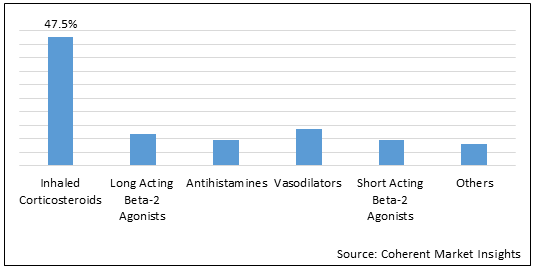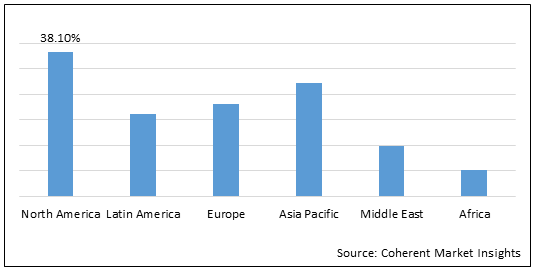Pulmonary drugs are used for treating the conditions affecting lungs like asthma, chronic obstructive pulmonary disease. The pulmonary drugs are used from treating minor illnesses such as the common cold to cure long-term disorders such asthma. These agents are available in different forms such as oral tablets, oral liquids, and injections or inhalations. Inhalations deliver the medicine directly to the lungs, which can act directly on the lung tissues, minimizing systemic side effects like unintentional weight loss, skeletal muscle dysfunction, an increased risk of cardiovascular disease, osteoporosis, and depression.
Global pulmonary drugs market is estimated to be valued at US$ 41.32 billion in 2022 and is expected to exhibit a CAGR of 8.1% during the forecast period (2022-2030).
Figure 1. Global Pulmonary Drugs Market Share (%), by Drug Class, 2022

To learn more about this report, Download Free Sample
Increasing tobacco smoking is expected to augment global pulmonary drugs market growth over forecast period.
Increasing incidence of Chronic Obstructive Pulmonary Disease (COPD) is directly proportional to the tobacco smoking and exposure. According to the World Health Organization (WHO) 2021, tobacco smoking is the primary cause of COPD leading to around 90% of Chronic Obstructive Pulmonary Disease (COPD) cases. The irreversible damages caused due to smoke leads to adoption of lifestyle adjustments and medical treatments that includes consumption of bronchodilators, inhaled glucocorticoids, inhaled steroids, and other pulmonary drugs to relieve the disease symptoms, thereby propelling demand for pulmonary drugs. Tobacco is major cause of death and illness across the world. The number of smokers is consistent globally and does not have a drop since a past few years. Smokers are highly susceptible to respiratory diseases such as COPD and asthma. For instance, in March 2022, according Centers for Disease Control (CDC), 30.8 billion adults in the U.S. smoked. Nearly 40 billion U.S. adults still smoke cigarettes, and an estimated 2.55 billion middle and high school students use at least one tobacco product, including e-cigarettes according statistical data provided in March 2022. For instance, September 2020, according to artoicle published in National Center for Biotechnology Information, every day, about 1,600 U.S. youth younger than 18 years smoke their first cigarette. Each year, nearly half a billion U.S. citizens die prematurely of smoking or exposure to secondhand smoke. Another 16 billion live with a serious illness caused by smoking. Each year, the U.S. spends more than $225 billion on medical care to treat smoking-related disease in adults.
Pulmonary Drugs Market Report Coverage
| Report Coverage | Details | ||
|---|---|---|---|
| Base Year: | 2021 | Market Size in 2022: | US$ 41.32 Bn |
| Historical Data for: | 2017 to 2020 | Forecast Period: | 2022 to 2030 |
| Forecast Period 2022 to 2030 CAGR: | 8.1% | 2030 Value Projection: | US$ 77.31 Bn |
| Geographies covered: |
|
||
| Segments covered: |
|
||
| Companies covered: |
Sanofi SA, Meda Pharmaceuticals, Circassia Pharmaceuticals Plc., AstraZenca Plc., GlaxoSmithKline Plc., Mallinckrodt Pharmaceuticals Plc., Cheisi farmaceutici S.p.A., Zambon Company S.p.A., Alaxia SAS, and Merck Sharp & Dohme Limited. |
||
| Growth Drivers: |
|
||
| Restraints & Challenges: |
|
||
Uncover macros and micros vetted on 75+ parameters: Get instant access to report
Figure 2.Global Pulmonary Drugs Market Share (%), by Region, 2022

To learn more about this report, Download Free Sample
Supportive government and non-government initiatives for preventing and curing pulmonary diseases are expected to accelerate the global pulmonary drugs market growth over the forecast period.
Government and non-government initiatives for preventing and curing pulmonary diseases, help patients to fight the diseases by providing sufficient medical care and education regarding the benefits of preventive measures as well as appropriate medications to curb the life threatening diseases such as Chronic Obstructive Pulmonary Disease (COPD). For instance, in 2017, according to the World Health Organization (WHO), more than 90% of deaths were reported due to COPD in low and middle-income economies. Thus, the WHO initiated Global Alliance against Chronic Respiratory Diseases (GARD) with a vision to provide required medical treatments to patients suffering from chronic respiratory diseases in low and middle income economies. This provision demands a significant quantity of medication that is expected to propel the pulmonary drugs market.
Global Pulmonary Drugs Market– Impact of Coronavirus (COVID-19) Pandemic
Since the COVID-19 virus outbreak in December 2019, the disease has spread to over 100 countries across the globe and the World Health Organization had declared it a public health emergency on January 30, 2020.
COVID-19 can affect the economy in three main ways: by directly affecting production and demand of drugs, by creating disruptions in distribution channels. Due to nationwide lockdowns, several countries, such as China, India, Saudi Arabia, U.A.E., Egypt, and others, faced problems with regard to the transportation of drugs from one place to another.
However, the COVID-19 pandemic had a positive impact on the global pulmonary drugs market, owing to the increased spread of infection of COVID-19. For instance, according to an article published by the National Center for Biotechnology Information, the major risk factors for severe COVID-19 are shared with idiopathic pulmonary fibrosis (IPF). Idiopathic pulmonary fibrosis (IPF), is a progressive disease in which lung function inexorably declines, leading to respiratory failure and eventually death with lung transplantation being the only treatment that improves outcomes. COVID-19 leads to a wide spectrum of respiratory diseases such as idiopathic pulmonary fibrosis and respiratory failure with an extremely high incidence of acute respiratory distress syndrome.
Global Pulmonary Drugs Market: Key Developments
In June 2021, Glenmark Pharmaceuticals Limited, a multinational pharmaceutical company, based in India, launched Tiotropium Bromide Dry Powder Inhaler, used in the treatment of chronic obstructive pulmonary disease (COPD), in the U.K., under the brand name – Tiogiva.
Global Pulmonary Drugs Market: Restraint
The major factors that hinder growth of the global pulmonary drugs market include stringent government regulations regarding pulmonary drugs approval. The strict regulatory scenario and the regulatory requirements of the drug delivery systems is presenting a challenge to market players because the pulmonary drug delivery systems are a combination of drug and device. Therefore, it is regulated under new provisions by governments of various countries. For instance, in April 2021, according to data published by Center for Disease Control, the (Prescription Drug User Fee Act) PDUFAVII reauthorization proposal described timely review of the safety and effectiveness of new drug applications (NDAs) and biologics license applications (BLAs) is central to the U.S. Food and Drug Administration (FDA)’s mission to protect and promote the public health – and Prescription Drug User Fee Act (PDUFA) is essential to these efforts.
Key Players
Major players operating in the global pulmonary drugs market include Sanofi SA, Meda Pharmaceuticals, Circassia Pharmaceuticals Plc., AstraZenca Plc., GlaxoSmithKline Plc., Mallinckrodt Pharmaceuticals Plc., Cheisi farmaceutici S.p.A., Zambon Company S.p.A., Alaxia SAS, and Merck Sharp & Dohme Limited.
Share
Share
Missing comfort of reading report in your local language? Find your preferred language :
Transform your Strategy with Exclusive Trending Reports :
Frequently Asked Questions
Select a License Type
Joining thousands of companies around the world committed to making the Excellent Business Solutions.
View All Our Clients